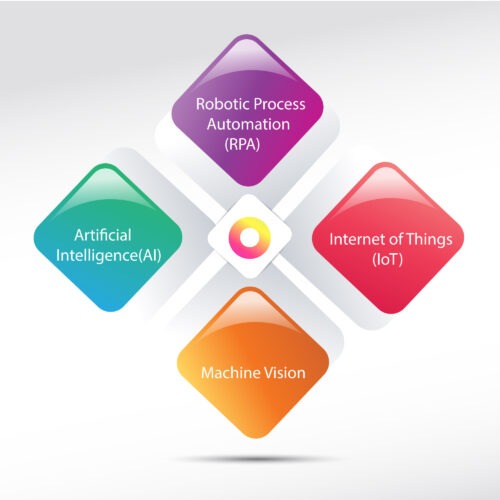
18 May Maximizing Productivity with Automation & Control
How automation & control of the production can help us improve our productivity
You must have been talking about automation & control to put it into practice for quite a while. As Productivity is the key to success in the competitive corporate climate of today. Companies will have an edge over their rivals if they create more with less time and resources. Automation & control technology can assist firms in achieving this objective by lowering mistakes, increasing efficiency, and allowing staff to concentrate on more essential duties. In this blog article, we’ll talk about how automation and control may boost workplace efficiency and the tools and methods that firms can utilize to put these systems in place.
Why Productivity is needed in Business?
Any business must be productive to prosper. It describes the capacity to generate things or services quickly, with less inputs, and in a shorter amount of time. Businesses may boost output, save expenses, and increase profitability by having high productivity. Low productivity, on the other hand, might result in fewer revenues, worse quality, and lower levels of client satisfaction.
In the fast-paced business world of today, when businesses must be flexible and adaptive to compete, productivity is particularly crucial. Automation & control systems may increase production levels in firms by minimizing mistakes, enhancing efficiency, and allowing staff to concentrate on more important duties.
The Benefits of Automation & Control in Improving Productivity
Automation & control technologies can provide several benefits for businesses looking to improve productivity:
Reducing Errors and Increasing Efficiency
The capacity of automation & control systems to lower mistakes and increase efficiency is one of its most important advantages. Human mistake is less likely to occur in automated operations, improving quality control and decreasing waste. Automated assembly lines in manufacturing, for instance, may boost output while sharply reducing the amount of faulty goods.
Improving Quality Control and Consistency
These systems may make sure that goods or services are reliable and up to par with standards of quality. Automated temperature control systems, for instance, may guarantee that food is stored at the proper temperature, lowering the danger of rotting or contamination.
Freeing Up Time for Employees to Focus on More Valuable Tasks
By automating daily tasks, employees can focus on other tasks like customer service, product innovation, etc. Like automated billing systems cut down on the time needed to process bills in the financial sector. This to free staff members up to work on more difficult duties.
What is Automation & Control?
Automation & control refer to the use of technology and processes to automatically control and monitor business operations. Automation involves using technology to perform repetitive tasks automatically, while control involves monitoring and regulating those tasks. Automation and control systems can range from simple, standalone devices to complex, integrated systems that manage multiple functions.
Examples of Automation & Control Systems in Various Industries
Multiple industries, including manufacturing, banking, retail, and healthcare, use automation and control systems. The following are some instances of automation and control systems:
Manufacturing: Assembly line robots and robotic process automation (RPA) may automate manufacturing operations, lowering mistakes and boosting productivity.
Finance: Automated accounting and financial systems can cut down on the amount of time needed to handle payments and invoices, increasing productivity and minimizing mistakes.
Retail: Inventory management tools can monitor inventory levels effortlessly, lowering the possibility of product shortages or overstocking.
Healthcare: Electronic medical records (EMRs) can automate patient data management, improving efficiency and reducing errors.
Common Automation & Control Technologies
Several technologies can be used in businesses, including:
Robotic Process Automation (RPA): RPA involves using software robots to automate repetitive tasks, such as data entry or invoice processing. RPA can significantly reduce errors and improve efficiency in businesses.
Artificial Intelligence (AI): AI is the automation of complicated jobs like customer service or financial analysis via the use of algorithms and machine learning. AI may assist organizations in increasing productivity, decreasing mistakes, and extracting important insights from massive volumes of data.
Internet of Things (IoT): To gather and share data, IoT includes connecting objects to the internet. IoT may assist companies in automating procedures and tracking activities in real-time, increasing effectiveness and lowering mistakes.
Machine Vision: Machine vision involves using cameras and software to analyze images and make decisions. Machine vision is being used in quality control processes today. These processes include inspecting products for defects or monitoring production lines for errors.

Advantages and Disadvantages of Different Automation & Control Systems
| System | Advantages | Disadvantages |
| Robotic Process Automation (RPA) | – Reduces errors and improves efficiency – Easily handle tiresome tasks – Low implementation cost | – Limited to tasks that follow pre-defined rules – Cannot handle complex decision-making – May require significant IT support |
| Artificial Intelligence (AI) | – Can systematize compound tasks – Can learn and handle new situations – Can improve efficiency and reduce errors | – High implementation cost – Requires significant data and computing resources – May raise ethical concerns regarding job displacement |
| Internet of Things (IoT) | – Can connect and automate devices for real-time monitoring and control – expand efficiency and decrease upkeep costs – Can provide insights into customer behavior | – Requires significant investment in devices and infrastructure – data privacy and security |
| Machine Vision | – Can improve quality control and reduce errors – Can automate inspection and monitoring tasks – Can provide real-time data for process improvement | – May require significant investment in equipment and software – May require specialized training and maintenance |
| Programmable Logic Controllers (PLCs) | – Can automate industrial processes – Can improve efficiency and reduce errors – Can handle real-time monitoring and control | – Limited to specific industrial applications – May require specialized training and maintenance – May be susceptible to cyber attacks |
Implementing Automation & Control in Your Business
Implementation of these systems in your business need careful planning and consideration.
Have a look at the following steps:
- Assessing your business processes to identify areas where it can improve productivity.
- Researching and selecting the right automation and control technologies for your business needs and budget.
- Testing and piloting the systems before fully implementing them.
- Providing training and support for employees to ensure they can use the systems effectively.
- Common Challenges and How to Overcome Them
- Implementing automation and control systems can also pose some challenges, such as:
- Resistance from employees who may feel threatened by automation.
- Integration challenges when implementing complex systems.
- Costs associated with purchasing and implementing automation & control technologies.
To overcome these challenges, you can:
- Communicate the benefits of automation and control to employees and involve them in the process.
- Work with vendors and consultants to ensure proper integration and implementation of systems.
- To calculate the possible ROI of the system, consider cost-benefit analysis.
How to maximize the Benefits of Automation & Control
- Continuously monitor and evaluate the systems to identify areas for improvement.
- Regularly update and maintain the systems to ensure optimal performance.
- Encourage employee feedback and suggestions for improving the systems.
Conclusion
Businesses aiming to increase production, eliminate mistakes, and give staff more time to work on worthwhile projects can greatly benefit from automation & control technology. Businesses may acquire a competitive edge and experience long-term success by carefully choosing and installing the appropriate automation & control solutions.